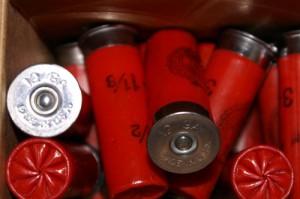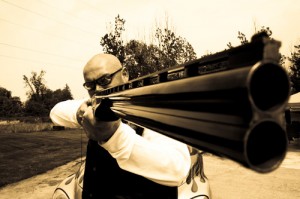There is ample reason why military forces continue to include shotguns in their active arsenals and sport hunters use them for particular game. While a rifle or a pistol has an advantage in regards to accuracy, in terms of self defense, there may not be sufficient time, lighting or other factors that would allow for a quick, accurate aim. In this respect, shotguns offer their own unique advantages. Multiple projectiles from one shot will have awesome stopping power. In the hands of a trained user, a shotgun may indeed be an appropriate weapon. Because there are so many options available in shotgun selection, we will discuss how to decide the right weapon for self defense.
Among the first considerations is the selection of the proper gauge. To better understand this option, shotguns are classified by size or gauge—the lower the gauge, the wider the barrel. Most popular (and rightly so for this purpose) would be a 12 gauge. Because of its popularity, the 12 gauge offers a wider variety of shell options.

To control the pattern size of your shotgun, an accessory called a choke comes into play. Chokes create differing amounts of constriction on the outlet of the barrel which controls the size of the pattern of the shot. To tighten the pattern of shot you must have a smaller choke on the barrel. An improved-cylinder or modified choke is quite effective and can be used in applications other than home defense (such as hunting). Such a choke will give you a 15 to 20 inch spread pattern at 10 yards.
The stopping power of shotgun ammunition comes from the pellets, known as shot or buckshot. Buckshot sizes range from #4 up to 000. Common birdshot comes in sizes #4 (this is an entirely different shell than #4 buckshot) up to around #9. There’s a #12 but it’s mostly a specialty order and not significant for home defense purposes. It’s at this point in the conversation that differing opinions occur about which shell to use. The utmost concern should be the safety of other occupants of the house and any neighbors nearby in determining which shell to use.
Some people advocate the 00 (double-ought) buckshot shell. The pellets in this size are about .33 caliber and there will be about 8 -12 of these pellets in a shell depending on the length of the shell and ounces of powder used. This is like releasing 8 – 12 .30 caliber rifle bullets at one time and is extremely dangerous. This shell will seriously over-penetrate walls, plumbing, electrical systems, heating and cooling systems, people and can even wind up in your neighbor’s living room, killing him. The shot in this shell is traveling fast enough and has enough mass that it will pass through anything.
A good middle of the road shell is a #4 birdshot (not to be confused with the #4 buckshot). The difference in the two shells is this: #4 buckshot contains approximately 21 .24 caliber pellets in 1 ounce of shot. #4 birdshot contains 135 .13 caliber pellets in 1 ounce of shot. Each is traveling at around 1200 feet per second. The difference is the buckshot will pass through the intruder while the smaller mass of the birdshot pellets will be stopped within the intruder’s body. This is the stopping power of the shell—the intruder is absorbing all the energy of the smaller pellets because they’re not passing through him. This is true knock-down power. Also, since your spread is dependent on the choke of your weapon and not the shell, you’d rather have 135 pellets in a 15” spread (with a modified choke) than 8 to 12 of them. With a #4 birdshot shell, you’re reducing the risk of over-penetration and the lives of other members of the family and neighbors, as well as the risk of serious damage to your house.
Another often overlooked factor to consider is the length and type of barrel. Hunters typically use longer barreled guns, but shorter barrels are easier to handle, especially in tight spaces. Although shorter is better, legality is an issue. Current laws require that barrels be at least 18 inches long on a weapon that is at least 26 inches in total length. The best advice I can give you on barrel length is to check with local authorities to determine size requirements where you live.
 These are the essential elements to an effective defensive shotgun, but a visit to any gun store may offer additional options and accessories. Guns come in many shapes, sizes, colors and textures, and with some experience you’ll be able to choose options best suited to your needs.
These are the essential elements to an effective defensive shotgun, but a visit to any gun store may offer additional options and accessories. Guns come in many shapes, sizes, colors and textures, and with some experience you’ll be able to choose options best suited to your needs.
Additional ammunition capacity can be added with available accessories, but these are not really necessary if your sole use is for home defense. Additional options such as laser sights and slings are also considered by many to be unnecessary in home defense applications. Laser sights and flashlight-style attachments are marketed as a way to give the user a visible field of vision in the dark, but they can also pinpoint your location, making you as much of a target as your intruder.
Pistol-grip stocks may make a gun look menacing, but in reality they are much less effective than the typical butt stock. They make the gun extremely hard to handle because of recoil. In addition, if you find yourself in a close–up encounter with an intruder, a shorter stock gun can enable your attacker to turn the weapon on you without it ever leaving your hands. A longer stock and barrel is unwieldy in close encounters, but is an advantage for you if the intruder gets his hands on your gun.
Shotguns also come in double-barrel, pump or auto configurations. Regardless of personal desire, the gun must be quick and reliable. The double-barreled shotgun is a tried and true design that doesn’t incorporate complicated loading or repeating mechanics. Double-barreled shotguns are not as easily mass produced though so they do tend to cost a little more.
Auto shotguns provide an advantage of an almost instant discharge of up to six rounds, but the complex mechanisms increase cost and can present a potential for failure.
For the best combination of price and performance, the simple pump shotgun may be the most reasonable solution for home defense. These guns are reliable and easy to use and because they are easily reproduced, there is not a premium included in the price. In addition, the shack-a-lack of a round being chambered in the pump shotgun is a universal language that informs the intruder you have a gun and will use it without ever speaking a word. 9 times out of 10 this will be enough of a deterrent, convincing him it would be better to leave than wind up dead.
In conclusion, shotguns are generally considered to be the most effective tool for home defense, but the most important component is your familiarity and training with the weapon that may one day stand between your loved ones and criminals bent on depriving you of your property or your life.
If you liked this article you may be interested in this product from our sponsor.

 Off The Grid News Better Ideas For Off The Grid Living
Off The Grid News Better Ideas For Off The Grid Living



